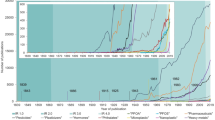Abstract
I HAVE analysed bittern and carnallite of industrial origin and deduced the concentration of cæsium-137 in the coastal waters in early 1958 of Japan as 70–150 µµc. kgm./l.1 Recently, by application of a low-level β-counting equipment, cæsium-137 has been successfully determined by direct treatment of 6–20 litres of sea-water.
This is a preview of subscription content, access via your institution
Access options
Subscribe to this journal
Receive 51 print issues and online access
$199.00 per year
only $3.90 per issue
Buy this article
- Purchase on Springer Link
- Instant access to full article PDF
Prices may be subject to local taxes which are calculated during checkout
Similar content being viewed by others
References
Yamagata, N., and Matsuda, S., Bull. Chem. Soc. Japan, 32, 497 (1959).
Yamagata, N., and Yamagata, T., ibid., 31, 1063 (1958).
Partly published in ‘Radiological Data in Japan II’, ed. by Y. Hiyama, ‘The Effects of Atomic Radiation’, U.N. Report Annex D, A/AC.82/G/R.30 (1958).
Author information
Authors and Affiliations
Rights and permissions
About this article
Cite this article
YAMAGATA, N. Concentration of Cæsium-137 in the Coastal Waters of Japan (1959). Nature 184, 1813–1814 (1959). https://doi.org/10.1038/1841813b0
Issue Date:
DOI: https://doi.org/10.1038/1841813b0
This article is cited by
-
Results of an investigation of the total ?-activity in water and air in several areas of the Pacific Ocean
Soviet Atomic Energy (1964)
-
Cæsium-137 in the Seas off the Cape of Good Hope
Nature (1962)
-
Estimation of the Levels of Cæsium-137 in Sea-water by the Analysis of Marine Organisms
Nature (1962)
-
Fall-Out Cæsium in Surface Sea Water off the California Coast (1959–60) by Gamma-Ray Measurements
Nature (1960)
Comments
By submitting a comment you agree to abide by our Terms and Community Guidelines. If you find something abusive or that does not comply with our terms or guidelines please flag it as inappropriate.



